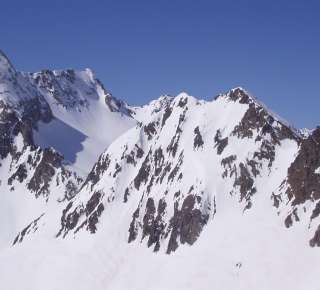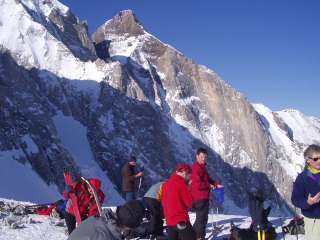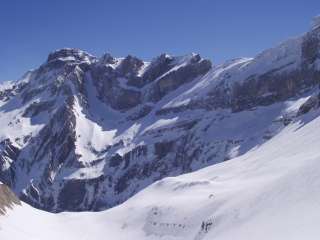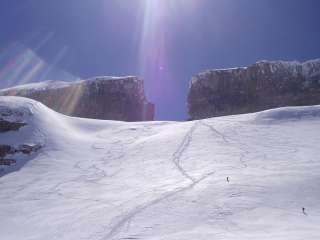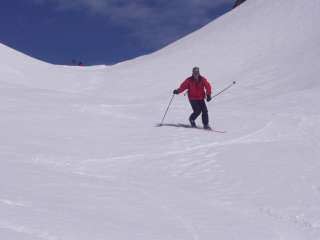Gavarnie, France – What can you say about
a day when you summit the highest peak in the French Pyrenees under the bluest,
most cloudless sky that you have ever seen, and then afterwards, following a
short rappel, you have a nearly 5,000 vertical-foot ski descent on soft spring
snow on a giant mountain all alone, except for your 12 newest best friends?
And then, when you think your adventures are over, you survive a hairy traverse
above a cliff band to avoid skiing down a waterfall, and a mellow cross country
ski along a river becomes a nail-biter as you have to hold an edge on a steep,
icy slope to avoid sliding into the river. Then, with your skis on your pack,
you have to cross four major piles of avalanche debris. Finally, just as you
get back to civilization, a lammerger – a bearded vulture, of which there are
less than 20 in Europe – soars in the cliffs overhead.
n
That was just one day out of a recent six-day ski
tour with Pyrenees Mountain Tours, a travel company that specializes in ski
touring in the Pyrenees and the Alps. It was founded about eight years ago by
Simon Greenleaf, and attracts most of its clients from the U.K. Along with guided
ski tours, they offer ski instruction and more traditional ski holidays in the
Pyrenees as well.
|
The Pyrenees are rather serious mountains |
SERIOUS MOUNTAINS
I remember first hearing about the Pyrenees while
studying European geography, and they were mentioned in passing as a minor mountain
range that separated France from Spain – nothing like the mighty Alps. Then,
when the Tour de France became a regular feature on American television, it
became apparent that there were some serious hills there. Spending time in the
Pyrenees, you get to understand that although they may not be as high as the
Alps, the Pyrenees are serious mountains.
I was the only American on this year’s tour of the
Pyrenees National Park. The other nine clients consisted of a Welshman, two
Scotsmen who proved the cliché of the dour Scots a lie, two English women and
four Englishmen , including a 62 year-old university lecturer whose fitness
and endurance were every bit the equal of his younger companions. In addition
to great senses of humour, pleasant characters, and easygoing natures – all
very important characteristics when spending so much time together in close
quarters – it was amazing how closely matched all ten of us were in ability
and fitness. In fact, the only real technical weakness in anyone’s skiing was
my own pitiful kick turn.
One of the best things about travelling with Pyrenees
Mountain Tours is that they handle all of the logistics. Most of us arrived
in Biarritz, next to the Atlantic Ocean near the French-Spanish border, where
we were met by a van that took us into the Pyrenees at Luz-Saint-Sauveur, a
small town that serves as Pyrenees Mountain Tour’s headquarters. We were booked
into the funky but comfortable Cimes Hotel where proprietor Marie-Hélène greeted
each of us with big, wet kisses on each cheek and, in a bit of a jolly mood,
started dinner by singing a traditional Pyrenees song.
This had been the biggest snow winter in the Pyrenees
for many years. Avalanches crashed down everywhere after almost a week of non-stop
snow in early February. Prior to our trip, however, clear, sunny days and cold
nights had stabilized the snow pack such that the avalanche danger was negligible.
The pattern of warm sunny days and cold, clear nights thankfully continued throughout
our week. In fact, a grand total of one cloud on Tuesday and two clouds on Friday
were the only minor blots on the perfectly deep blue sky.
|
Climbing above the Wallon hut
Guides Richard and Rémi |
Originally, we were meant to ski up a long valley
and cross the border into Spain on our first day, but the hut at which we had
intended to stay had been closed during the winter since access from the Spanish
side required passing through many avalanche paths. Instead, we started from
the ski de fond (cross country skiing) area at the Pont d’Espagne. From
there it was an easy two- to three-hour ski up to the Wallon Hut where we would
now spend our first two nights. I was the only skier on telemark equipment.
In fact, it felt almost like it did ten years ago when telemark skiers were
such a novelty. Everyone else in the group, including the guides, was on randonnée
or Alpine touring equipment. Nobody laughed at my joke about randonnée being
French for “can’t telemark,” but I could see that I was a bit of a novelty item.
By the time we got to the hut I am pretty sure that
many people wished they had different boots. The fairly gradual climb apparently
caused major rubbing for the randonnée set, and by the time we were at the hut
half of the group had the beginnings of major blisters that would require daily
treatment.
We were led by two qualified local guides, Richard
and Rémi. Rémi had just completed a major ice climb on the Cirque du Gavarnie
that we saw written up in a French climbing magazine. He was quiet, though his
English was quite good. Richard projected an air of always being in total control.
This went from his skiing, to his route finding, to his scrabble (he made a
seven-letter word in English) and card playing in the huts (all kinds of weird
French games with 10 being higher than kings and things called a chien
and a bou determining the winner of the game). The two of them together
made us feel very safe, no matter what the mountains had in store for us.
The Wallon hut turned out to be the plushest of
the huts that we would visit during our week. The night before we arrived it
had accommodated 100 guests. We were only 12, and there were only 10 others
to join us on the first night. The hut had indoor flush toilets and running
water, and we each had our own individual bed in the top-floor dormitory. After
lunch we climbed about 300 meters above the hut so that the guides could make
sure that we all could ski. They had thought of dividing us into two groups,
but since we were all on pretty much the same level that never happened, and
decisions regarding different routes were made more on ambition than ability.
After a ski down in very mixed conditions, soft
in the sun but hard away from it, we returned to the hut and began our late-afternoon
ritual of sitting outside in the sun and drinking beer – always the best way
to finish your ski day.
PLUSH HUTS AND CRAMPED CRAMPONS
Meals in the mountain huts are generally very hearty.
The dinner process became somewhat of a ritual of its own – bowls are passed
out first, and then you always get a soupspoon, a teaspoon, a fork and knife.
The bowl is used for the soup that always represents the first course. With
the completion of each course the utensil is taken away, but the bowl remains
throughout the meal. Luckily, the soup was delicious since its residue flavored
the rest of the meal. Given its location on the French side of the border, at
the Wallon hut, there was an extra cheese course before crème brulée for desert.
Wine was available with the meal as well – it was quite a civilized place.
|
Climbing toward the Col de la Fache |
We undertook a major day trip the following morning.
The group divided on the 800-meter climb to the Col de la Fache. Even with our
light packs, it was tough going in the warm sun. I also had my introduction
to haschhieseen – ski crampons. They attach to the binding and can dig
into hard, icy snow. For the touring bindings, the haschhieseen are well-designed
and clip right in, but for telemark bindings it was more hit and miss, which
would nearly prove a disaster later in the trip. From the col, we summitted
the Pène d’Aragon at el. 2,875 m by skiing right to the top. We had a wonderful
1,000-meter ski back to the hut ahead of us. This was the first real downhill
ski of the trip and for the first time we had the sense of a limitless ski playground,
endless acres of downhill adventure all to ourselves, earned through the effort
and sweat on the way up. There was no rush to get down – in fact, we stopped
part way down in a spot just below the Grande Fache that totally protected from
the wind to eat our lunch before continuing back to the hut.
On the third day we packed up and left the Wallon
hut and headed for the Refuge des Oulettes de Gaube, a smaller hut that lies
in a flat valley facing the daunting north face of the Grande Vignemale, the
highest peak in the French Pyrenees and the fourth highest in the entire range.
We climbed totally in shade up a gradually ascending valley to the Col d’Arratille.
We needed our haschhieseen for the still-frozen snow, and someone pointed
out that mine seemed loose. It turned out that it had actually cracked and broken
off, reducing my equipment to a single ski crampon, so I tried to keep most
of my weight on the right ski for any remaining icy climbs.
From the col we skied down into Spain. Skiing with
an unnecessarily full pack put a bit of a crimp in my telemark turns, but it
was fun to be skiing downhill into the sunshine. An alternate route bagging
the peak Alphonse Meillon was offered, but with the following day’s schedule
including the ascent of the Vignemale and the promise of a much better ski slope
near the hut, it was not difficult for Richard to discourage any interest in
the alternative route.
The next climb to the Col des Mullets (the Pass
of the Mules) wore me out more than any other on the trip. It was not more than
300 meters, but it was all in direct sunlight and Rémi kept a steady, relentless
pace. From the Cold des Mullets it was an easy ski back into France and down
to the hut.
|
Refuge des Oulettes de Gaube
Deskinning in the Hourquette d’Ossoue |
The Refuge des Oulettes de Gaube, which we took
to calling the Omelette’s hut, is managed by a striking, tall red-haired woman
who took over the hut’s operation after the previous caretaker was killed in
an avalanche. It was much smaller than the Wallon hut, and our sleeping quarters
were two large shelves with numbered spots for lying down. The hut attracts
many climbers attempting to ascend the coveted North Face of the Vignemale.
Like all the huts, it is situated in such a way that it catches the afternoon
sun, an undeniable draw that kept all but one other person from joining the
guides and myself for an additional (pack-free) climb to the Col d’Arraile,
followed by a 400-meter ski down a west-facing slope. The single hour’s effort
delivered the downhill highlight of my trip. Perfectly soft corn was the order
of the day all the way down, including the very steep final 400 feet that we
really ripped for the entertainment of our sunbathing audience on the rocks
beside the hut.
TO THE TOP OF THE PYRENEES
Wednesday was our first epic day. Moonlight still
lit the west-facing slopes of the previous afternoon as we left the hut by 7:00
and climbed the 600 meters to the Hourquette d’Ossoue, a col of 2,734 meters.
The climb was fairly steep, but the last 100 feet was solid ice, and I was relieved
that my single haschhieseen held up until I was over the top. We descended
into the sunlight with the Petit Mignemale (el. 3,032 m), which is quite imposing
in its own right, looming over our right shoulders.
While the north face of the Vignemale is a technical
climb, the south side is covered in a glacier that makes it ascendable on skis
to almost the summit. We skied down from the pass to the foot of the glacier
and stashed a lot of unneeded gear under a rock before beginning the 800-meter
ski up the glacier. Once again, we were climbing in strong sunshine and though
it was not steep, the climb was exhausting with a series of false tops. We
stopped just below a final steep slope that did not look skiable.
We removed our skis and many donned boot crampons
for the first time. Rémi, without crampons, kicked steps into the final ascent
and we all followed. The crampons provided an immense sense of security and
the 150-meter climb was easily accomplished before we found ourselves on a narrow
ridge that led easily to the summit. The walk was easy, but dizzyingly exposed
on all sides, and I was uneasy to be perched upon such a narrow spot with 12
other people.
The views were endless, but we soon had to make
our way down. We probably could have walked down, but even with the crampons
it was disconcerting to face such a steep slope. The guides set up a rope,
and using our backs for friction we rappelled most of the way down to our skis.
From the top of the French Pyrenees we now had an
almost 5,000-foot ski down to the town of Gavarnie, where we would spend the
night. The snow varied from a bit of dust on crust – a single cloud the night
before had deposited almost an inch of snow – to windblown, hard pack, and a
few areas of beautiful corn. As we streamed down endless snowfields, one skier
was heard to exclaim, “Eat your heart out, Val d’Isere!”
The glacier led into a gully choked with avalanche
debris before opening onto a lake. Between the gully and the lake, however,
was a roaring waterfall, and the guides led us along a cliff band that accessed
some softer avalanche debris en route to the lake. We regrouped at a dam at
the head of the lake before heading off on a wild ski along a riverbank. Although
mostly mellow, in a few spots the snow had not softened and we were edging on
steep slopes with a freezing torrent raging below.
When we crossed a bridge and took off our skis,
we had completed a descent of over 1,600 meters from the top of the Vignemale.
With the skis attached to our packs, we walked down a road that had been hit
by at least four major avalanches. Walking through the debris was a bit of
a chore – at one point, the block of ice that I was standing on gave way, and
I thought that I was going to sink all the way in.
By the time we met the van and had removed our boots
outside a very plush hotel and ordered the first round of beers in Gavarnie,
it had been more than 10 hours since we had clipped into our skis outside the
Refuge des Oulettes hut that morning. After 1,400 meters of climbing, the bagging
of a major peak, and 1,600 meters of adventurous descent this was definitely
an epic day.
"LIKE SOMETHING OUT OF A MOVIE SET"
|
The Cirque du Gavarnie |
Gavernie is a small scenic town that is well-placed
less than a mile north of the massive Cirque du Gavernie, a massive wall of
rock that rises more than 1,000 meters and boasts Europe’s highest waterfall
in the summer and some spectacular ice climbing on its north-facing cliffs in
winter. Just west of the Cirque is the most famous mountain pass in the Pyrenees,
the Breche du Roland, a 40 meter-wide by 150 meter-high slot through solid rock
that, according to legend, was carved by the sword of Roland as he tried to
escape from Spain back to France.
All that, however, lay ahead as we cleaned off four
days of grime and recivilized oursleves for an evening in the very comfortable
Marbore Hotel. The next day would be our easy day as, in addition to fresh
croissants for breakfast and a leisurely 8:15 start, we got to ride the ski
lifts at the Gavarnie-Cedres ski station to our day’s starting point.
When we arrived at the ski area we were not alone,
as there was quite a large crew of skiers with alpine touring gear who were
all carrying yellow and red flags. It turned out they were marking the course
for the upcoming weekend’s Gavarnie Derby, a ski mountaineering race that would
take the competitors up and down two major peaks in about three hours. Whereas
we were happy to climb 350 to 400 meters per hour, and Richard and Rémi said
that they cover about 800 meters per hour when they ski on their own, the competitors
in this race would climb over 1,300 meters in an hour! Ski mountaineering races
have been popular in Europe for some time, and in fact were featured in the
Winter Olympics of 1924 and 1948, and now are experiencing a revival in the
U.S. We were sorry we were not going to be able to see these supermen ski.
By comparison, our ski was an easy traverse, with
a bit of climb from the top of the ski area. As we came to our first rest stop,
two lammergers flew overhead barely a hundred feet above us. We watched them
for quite a while, feeling very privileged that we had seen this rare bird three
times in the past two days.
|
The Breche du Roland |
We skied around a corner and the Breche loomed ahead,
like something out of a movie set. Looking at it from below, it really looked
like someone had taken great care to carve such a massive passageway through
the rock. After a bit of a slog we were in the Breche itself, and our climbing
was over for the day.
The ski down the Spanish side was more of a traverse
than a descent. We basically clung to sidehills and rode our edges until we
came to the Goriz refuge, on the south side of Monte Perdido, the third-highest
summit in the Pyrenees. In addition to Spanish beer, hearty lamb shanks and
a nice red wine, The Goriz refuge stood out for its novel approach to toilets.
The bathrooms were only about 200 feet from the main hut but they were approached
via a walkway that led through a four-foot high tunnel that had been dug through
the snow. My nocturnal bathroom visit that night was truly memorable.
BACK TO CIVILIZATION
Our last day would prove the most adventurous, even
without the side trip to the summit of Monte Perdido. We started on a steep
south-facing slope behind the hut, which had totally iced over during the night.
Since I was down to a single haschheissen, it seemed safer for me to
climb with crampons, and I met the group at the first flattish area and switched
to skis. On the next steep pitch, my single haschheissen also gave up
the ghost and I slid off the traverse, losing more than 50 feet of hard-won
vertical. Luckily, I found a somewhat softer area and made the second flat via
a strenuous sidestep.
The last pitch to the Paseo del Cilindro, about
300 meters below the summit of Monte Perdido, was too steep and icy to even
think about ascending on skis. We all put on crampons and slogged our way to
the high pass. It was barely 9:30 and we had already climbed about 700 meters,
but our day’s adventure was just beginning.
The descent of the north face of Monte Perdido started
off nicely on decent snow, but then Richard told us all to stop as he climbed
an outcrop for a better look. We all stood in single file on a narrow traverse
as Richard dug his skis deep into the snow and looped a rope around them. “It
gets narrow and much steeper,” he said as Rémi attached a second rope and descended
out of sight. The strong sun and the anxiety of what lay ahead both had us all
sweating, but just as we were about to start down Richard announced that three
climbers were coming up the gully. In thousands of acres of emptiness, two groups
had picked the same gully at the same time on the same day.
Once the climbers had cleared, one by one we each
did a ski rappel down the gully. It started off at about 40 degrees and wide,
but steepened as it continued, and just as the knot from the joining of the
ropes got itself caught in your pack the rope dropped over a rock ledge. This
meant that you had to step backwards and maneuver through a 50-degree, six foot-wide
passage in the rocks before the gully widened and you could ski out. Once you
were done yourself it was fun to watch the others, who all made it with no problems.
Richard broke down the belay and skied down to the throat and did a good job
sidestepping down through the narrow opening.
Down in the valley, a 250-meter wall of snow lay
in direct sunlight ahead of us. A narrow gap in the rock called the Breche de
Tuquerouye loomed above, with a tiny hut perched in the gap that barely seemed
wide enough to hold two people. We skied about three switchbacks up before it
became too steep, and we took our skis off for a scramble to the top.
We ate lunch, trying to find a place for twelve
butts to seat on the narrow col as we looked back at the gully that we had sort
of skied, and looked forward to another 40-degree slope that we would ski after
lunch.
The ski down from Tuquerouye was a combination of
sideslipping and survival turns, as the promising slope was covered with rotten,
crusty snow. Endless sloughs followed us down, and we were all very happy that
the snowpack was as stable as it was.
|
The author’s telemark equipment was a novelty amongst |
One more 300-meter climb was all that separated
us from our beautiful 800-meter home run into Gavarnie. The climb seemed straightforward,
but as we ascended the steepest pitch the snow turned to sugar under our skis.
It fell away as you attempted a kick turn, making for some difficult going,
and it was with some relief that we reached the Hourquette d’Alans and its giant
bowl stretched out below us. After some initial crust, we revelled in some west-facing
corn snow and danced down through endless turns until it finally gave out in
a wooded area just above town.
Though a celebratory night, lay ahead, one that included 11 yards of ale in
a session that for many lasted well past 3 a.m., the trip really ended as we
strapped our skis to our packs for the walk through the forest towards Gavarnie.
As we stood by the road, with the massive Cirque of Gavarnie rising behind us
and the Breche of Roland almost visible to the west, another lammerger soared
over our heads. As if we needed another spectacle to remind us what a special
week it had been!

